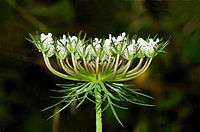Umbel
An umbel is an inflorescence which consists of a number of short flower stalks (called pedicels) which spread from a common point, somewhat like umbrella ribs. The word was coined in botany in the 1590s, from Latin umbella "parasol, sunshade."[1] The arrangement can vary from being flat topped to almost spherical. Umbels can be simple or compound. The secondary umbels of compound umbels are known as umbellules or umbellets.[2] A small umbel is called an umbellule.[2] The arrangement of the inflorescence in umbels is referred to as umbellate, or occasionally subumbellate (almost umbellate).
Umbels are a characteristic of plants such as carrot, parsley, dill, and fennel in the family Apiaceae; ivy, aralia and fatsia in the family Araliaceae; and onion (Allium) in the family Alliaceae.
An umbel is a type of indeterminate inflorescence.[2][3] A compressed cyme, which is a determinate inflorescence, is called umbelliform if it resembles an umbel.
Gallery
- Compound umbel of a hemlock-parsley, Conioselinum pacificum (Apiaceae)
 Compound umbel of a wild carrot, Daucus carota (Apiaceae)
Compound umbel of a wild carrot, Daucus carota (Apiaceae) Simple umbel of Fatsia japonica (Araliaceae)
Simple umbel of Fatsia japonica (Araliaceae).jpg) Involucrate simple umbels of Primula veris.
Involucrate simple umbels of Primula veris.
References
Further reading
- Hinderer, Walter; Noé, Wolfgang; Seitz, Hanns Ulrich (1983). "Differentiation of metabolic pathways in the umbel of Daucus carota". Phytochemistry. 22 (11): 2417–2420. doi:10.1016/0031-9422(83)80131-9. ISSN 0031-9422.
- Toben, H.-M.; Rudoph, K (1996). "Pseudomonas syringae pv. coriandricola, Incitant of Bacterial Umbel Blight and Seed Decay of Coriander (Coriandrum sativum L.) in Germany". Journal of Phytopathology. 144 (4): 169–178. doi:10.1111/j.1439-0434.1996.tb01510.x. ISSN 0931-1785.
- Peterson, L. E.; Clark, R. J.; Menary, R. C. (1993). "Umbel Initiation and Stem Elongation in Fennel(Foeniculum vulgare)Initiated by Photoperiod". Journal of Essential Oil Research. 5 (1): 37–43. doi:10.1080/10412905.1993.9698168. ISSN 1041-2905.